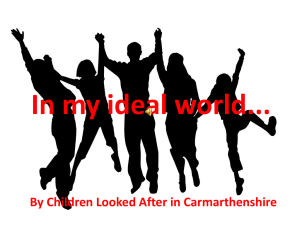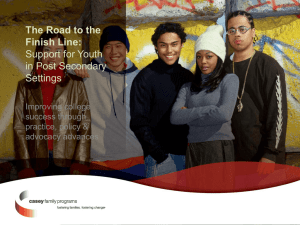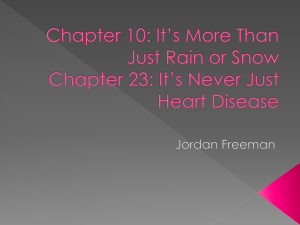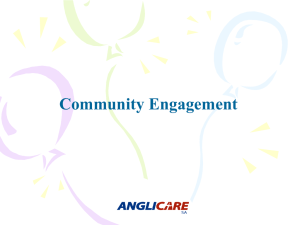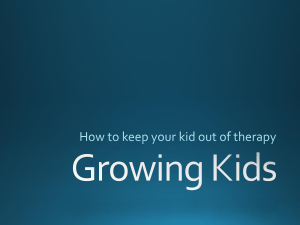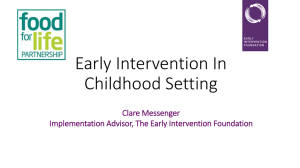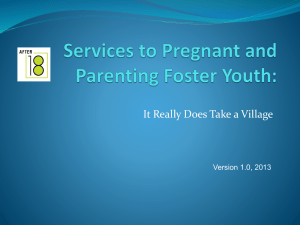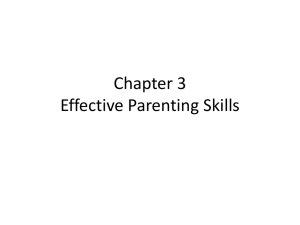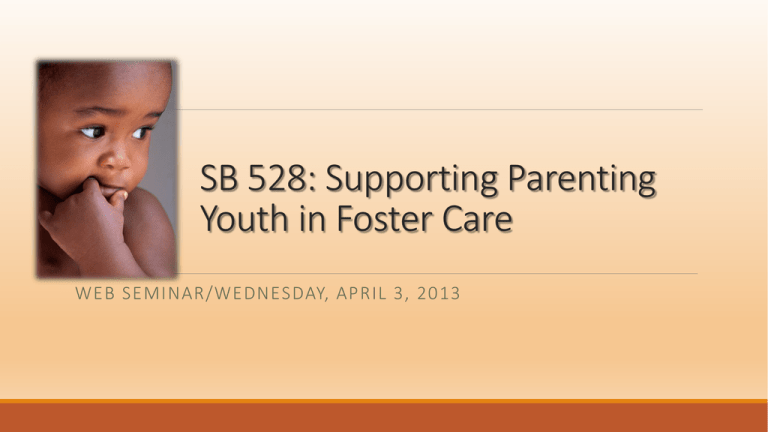
SB 528: Supporting Parenting
Youth in Foster Care
WEB SEMINAR/WEDNESDAY, APRIL 3, 2013
Information to Participate
Call-in number is 702-489-0004 and access code
is 754-235-388.
To submit live questions, click on the
“Questions” panel, type your question, and click
“Send”
Presentation materials and audio will be posted
at www.johnburtonfoundation.org
Today’s Presenters
Amy Lemley, John Burton Foundation
Jody Green, Children’s Law Center
Barbara Facher, Alliance for Children’s Rights
Mara Ziegler, Public Counsel
Martha Matthews, Public Counsel
Alicia Lewis, Office of Senator Leland Yee
What are the goals of SB 528?
Greater knowledge of sexual development and reproductive health among foster youth
Fewer unintended pregnancies and subsequent pregnancies
Earlier access to prenatal care
Fewer children of parenting foster youth maltreated and placed into foster care
Higher levels of educational attainment among parenting foster youth
Higher levels of engagement among young fathers in their children’s lives
Better data on parenting youth and their children in California
What does California do for parenting
youth in foster care?
Infant
Supplement
($441/month)
• Paid to caregiver
with exception of
SILP
Whole Family
Foster Home
• Established
through SB 500
• Strong model,
limited
implementation
Different
individual
approaches by
county
Why is it urgent to change our practice
NOW?
AB 12 extended foster care to age 21
By age 21:
• 3/4 young women in foster care will have experienced a pregnancy
• 1/2 will be custodial parents to at least one child
Children of parenting foster youth are five times more likely to
have spent time in foster care than the children of same-aged
mothers in the general population
Four Key Provisions of SB 528
1. Access to information about sexual development &
reproductive health
2. Improved planning through specialized conferences
3. Access to subsidized child care
4. Requirement to collect data on parenting and pregnant
youth and their children
Sexual Development &
Reproductive Health Education
Provision #1
Lack of clarity about who is responsible for educating foster youth
about sexual development & reproductive health
In a survey of
California
social workers:
• 23% regularly provide this
information to young men
• 34% regularly provide this
information to young women
• only 1/3 reported discussing
prevention issues with half or more
of the youth they serve
Programs for the general teen population
are inadequate
California's Investment in Teen Pregnancy Prevention ($millions)
50
46.4
45
40
35
30
25
20
12.9
15
10
5
2007-08
2011-12
0
This has resulted in 94% decline in total participants served by all teen pregnancy prevention programs
Lack of information contributes to high
rates of pregnancy
Teen girls in foster care are 2.5 times more likely to become
pregnant by age 19 than those not in foster care
3/4 young women in foster care report being pregnant at age
21 as compared to only 1/3 of those in the general population
More than half of the young women and nearly one-third of the
young men in an Illinois study had at least one child at age 21,
as compared to 24% of women and 12% of men of the same age
in the general population
How will SB 528 help?
SB 528 would ensure:
all dependent children ages 12 and older are informed of
their rights to receive these minor consent health services
all dependent children ages 12 and older have access to
these minor consent health services as needed
all dependent children receive age-appropriate, medically
accurate information about sexual development,
reproductive health, and prevention of unplanned
pregnancy and sexually transmitted infections on an
ongoing basis
SB 528 Minor Consent
Health Services:
Diagnosis and treatment
of sexual assault
Prevention or treatment of
pregnancy
Prevention or treatment of
infectious, contagious, and
communicable diseases
Mental health services
Treatment of alcohol and
drug abuse
Important clarification:
SB 528 requires the social worker to ensure minor consent
health services and access, but does not require the social
worker to provide it. Who could?
Public health nurse
Community based organization
Health outreach worker
Foster parent
FFA social worker
Improved planning through
specialized conferences
Provision #2
Modeled after current practice in Los Angeles County
Began in 2008
Voluntary; estimated 95% of youth elect to participate
150 conferences held in last 12 months
Social workers from Alliance for Children’s Rights and Public Counsel
serve as advocates for teen parents
Children’s Law Center of California conducting evaluation
Pregnant youth in foster care often do not
receive timely access to prenatal care
A survey of child welfare
workers in California found that
on average, only 1 in 5 child
welfare workers thought that it
was their responsibility to refer a
pregnant youth for prenatal care
An Illinois study found that 22
percent of youth did not receive
any prenatal care during the first
six months of their pregnancy
Late access to prenatal care is associated with poor birth outcomes,
including prematurity, birth defects and maternal depression
Youth also receive inadequate information
about preventing subsequent pregnancies
In a survey of child welfare workers in California, only half
stated that they regularly discuss preventing subsequent
pregnancy with foster youth who were pregnant
30% of female foster youth who have been pregnant
will experience a second pregnancy before age 21
Subsequent pregnancies have serious
implications
An
Illinois
study
found…
Each additional child
increased the odds of
having a child placed in
foster care by 54 percent
Each additional child
reduced the odds of having
a high school diploma or
GED by 45 percent
Early results of PPT conferences in Los
Angeles
→Earlier referrals to prenatal care
→Proactive consideration about how
pregnancy may affect placement, pre and
→Timely referrals to evidence-based Nurse post-birth
Family Partnership or other home visitation
program
→Access to parenting classes and child
development/early intervention services
→Social and emotional support for the youth
→Access to information about infant care
→Access to information about preventing
and subsidized child care
subsequent pregnancies
→Increased involvement of youth fathers
→Increased knowledge about available
maternal and child resources
→Linkage to other relevant resources (e.g.
substance abuse treatment, family law
→Improved planning about how pregnancy services, advice on outstanding tickets, etc.)
will affect school
How would SB 528 implement these
conferences?
Provide access to social
workers or resource
specialists trained on the
needs of teenage parents
and available resources
Offer youth a specialized
conference
Update youth’s case plan
within 30 days of
disclosure of pregnancy
Conference would include family members, other supportive
adults, trained social worker, resource specialist, and it may include
public health nurse, community health worker or other personnel
from public or private sectors with comprehensive knowledge of
available maternal and child resources, including public benefit
programs.
No penalty if the youth is
unable or unwilling
participate in the
specialized conference
Improving access to subsidized
child care to promote education
Provision #3
We know parenting foster youth are often academically
delayed before they give birth:
Over forty percent of parenting foster youth scored in the
lowest quartile on basic math and reading tests in eighth grade
The mean grade-point average for parenting foster youth
in ninth grade was 1.35 for females and 0.96 for males
This trend continues once they become
parents
High School Diploma or GED by Age 21
100%
89%
90%
77%
80%
70%
60%
51%
50%
40%
30%
20%
10%
0%
Teen parent
Non-parenting foster youth
General population
Subsidized child care is out-of-reach for
parenting foster youth
Percent who are receiving or have applied for subsidized child care
19%
20%
18%
16%
**Data from SOC 405E
14%
11%
12%
10%
9%
8%
4%
6%
4%
2%
0%
January 2009 to
December 2009
January 2010 to
December 2010
January 2011 to
December 2011
January 2012 to
December 2012
How will SB 528 help?
SB 528 would ensure:
parenting youth are not absent from school because of a lack of
reliable, affordable child care
parents who are foster youth would be added as a priority
population to the current system of subsidized child care
Require the collection of data
on parenting and pregnant youth
Provision #4
In California, we cannot answer the following questions:
→How many parenting youth are in
foster care?
→Where are parenting foster youth
placed?
→How many are young men vs. young →Is there racial disproportionality
women?
among parenting foster youth?
→How many of their children have been →How do they fare relative to nonremoved and placed into foster care? foster youth in AB 636 measures and
federal outcome measures?
→What part of the state experiences
higher rates of parenting teens?
Other states have this information…
Profile of parenting youth in Illinois:
Long foster care stays:
Over half of the females and two-thirds of the males had been in care for 7 years or
more.
Disproportionately
African American:
A full 86 percent of pregnant and parenting foster youth were African American.
Disproportionately
disabled:
One-quarter of females and 30 percent of males were identified as having some
sort of disability.
More likely to be
placed with a relative:
The most common first placement for a parenting youth was with a relative.
Runaway history:
One-fifth of females and one-quarter of males had run away from placement.
Age:
Mean age was 17.8 years old; one-quarter were 15 or 16 when they first gave birth.
…and use it to improve services for
parenting foster youth & their children
Illinois provides pregnant and parenting youth with:
→family planning
→mental health and drug and alcohol counseling
→parenting education and support
→prenatal and post-natal care
→child care and crisis intervention
These services are provided by a private child welfare agency that created a
network of providers in five regions of Illinois
Attention to the needs of parenting youth resulted from a class action law suit
These investments can help parenting foster
youth and their children.
Illinois is closing the educational gap among its parenting foster
youth.
The rate of high school or GED completion rate among IL
mothers in foster care at age 21 is 71 percent.
This is only slightly lower than the rate for non-parents in foster
care (77 percent) and considerably higher than the rate
experienced by teen mothers at age 21 (51 percent).
How will SB 528 help?
SB 528 would require:
the new CWS/CMS database to include a mandatory field
that will track parenting youth and their children
the State to develop interim procedures until the new system
is developed in 2017
Where is SB 528 in the legislative
process?
Senate
Human
Services
Committee
Senate
Education
Committee
Senate
Judiciary
Committee
Full Vote of
Senate
Senate
Appropriations
Committee
If successful,
then off to
the
Assembly!
Will you help make SB 528 a reality?
Submit a letter of support
Sample letter can be found at John Burton Foundation website under Projects
Submit ASAP!
Visit legislators on Monday, April 22nd
Email Simone Tureck at simone@johnburtonfoundation.org
Visit your Senator or Assembly Member in the district
Write an op-ed
Visit the www.johnburtonfoundation.org for support material
QUESTIONS or COMMENTS?
To submit live questions, click on the “Questions” panel, type
your question, and click “Send”
or contact
Angie Schwartz, Alliance for Children’s Rights
Jody Green, Children’s Law Center
Amy Lemley, John Burton Foundation
Martha Matthews, Public Counsel
Sources
Midwest Evaluation of the Adult Functioning of Former Foster Youth: Outcomes at Age 19
Midwest Evaluation of the Adult Functioning of Former Foster Youth: Outcomes at Age 21
Pregnant and Parenting Foster Youth: Their Needs, Their Experiences (2009)
“Sex Education and Reproductive Health Needs of Foster and Transitioning Youth in Three California
Counties” by Wendy L. Constantine, BA. Petra Jerman, PhD, MPH, Norman A. Constantine, PhD of the
Public Health Institute, March, 2009
“Teen Pregnancy Prevention in California after State Budget Cuts” by Jan Malvin, Ph.D. of the Bixby
Center at the University of California San Francisco, February 201
State of California 405: Exit Outcomes for Youth Aging Out of Foster Care Quarterly Statistical Report
(January to December 2012)
Teen Childbearing, Education and Economic Well-Being, The National Campaign to Prevent Teen and
Unplanned Pregnancy, July 2012.

